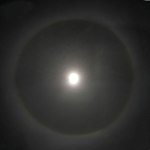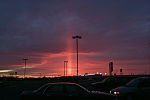Halo (religious iconography): Difference between revisions
Redirecting to Halo (disambiguation) |
|||
| Line 1: | Line 1: | ||
#REDIRECT [[Halo (disambiguation)]] |
|||
:''For other uses<!--comment at talk before reverting-->, see [[Halo (disambiguation)]].'' |
:''For other uses<!--comment at talk before reverting-->, see [[Halo (disambiguation)]].'' |
||
<!-- |
<!-- |
||
Please do not discuss the video game on this page; Wikipedia policy is to discuss the most common meaning on the "Article" page, and other meanings in the "Article (subject)" page. There is already a series of well-written articles about Bungie's Halo. --> |
Please do not discuss the video game on this page; Wikipedia policy is to discuss the most common meaning on the "Article" page, and other meanings in the "Article (subject)" page. There is already a series of well-written articles about Bungie's Halo. --> |
||
Revision as of 02:48, 13 July 2006
Redirect to:
- For other uses, see Halo (disambiguation).
A halo (Greek: χαλοσ; also known as a nimbus or Gloriole) is a ring of light that surrounds an object. They are often used in religious works to depict holy or sacred figures. In Christian sacred art (Eastern and Western churches), holy persons (saints) are depicted with a halo in the form of a golden, yellow or white circular glow around the head.
Halos, also known as icebows, are also optical phenomena that appear near or around the Sun or Moon, and sometimes near other strong light sources such as street lights. There are many types of optical halos, but they are mostly caused by ice crystals in cold cirrus clouds located high (5–10 km, or 3–6 miles) in the upper troposphere. The particular shape and orientation of the crystals is responsible for the type of halo observed. Light is reflected and refracted by the ice crystals and may split up into colors because of dispersion, similarly to the rainbow.
Religious iconography
The halo has become an object of religious iconography in both Christian and Buddhist traditions.
In Christianity
The halo represents an aura or glow of sanctity which was most prominent around the head and was conventionally drawn as a circle. It first appeared in the art culture of ancient Greece and Rome, and was incorporated into Christian art sometime in the 4th century.

Round halos are typically used to signify saints — i.e., people considered as spiritually gifted. A cross within a halo is used to represent Jesus. Triangular halos are used for representations of the Trinity. Square halos are used to depict unusually saintly living personages.
The use of halos to designate Christian saints presented a problem in the translation of the Hebrew Bible. When Moses came down from Mount Sinai carrying the tablets of the law, he is said in the Hebrew text (Exodus 34, 29) to have a glowing or radiant face. However, this would have implied a halo, which was reserved for Christian-era saints. Jerome avoided this by translating the phrase into Latin as "cornuta esset facies sua" (his face was horned). This mistake in translation is possible because the Hebrew word "keren"'s exact translation is unknown. There, the radiance of Moses's face is called "karan ohr", which could mean "rays of light", "horns of light", or something completely different.
The description of horns, however, was taken literally by Medieval and Renaissance artists, who depicted Moses with small horns growing from his forehead. Especially noteworthy in this respect is Michelangelo Buonarroti's statue of Moses in San Pietro in Vincoli.
In popular piety, this practice has led to the literal belief that saints' have visible halos around their heads, rather than it be understood as a metaphorical representation. Some faithful believe the halo to be equivalent to the Eastern religion aura, and as with the latter, believe that halos are visible to those with perception. Of the many stories about saints, some reports claimed that a saint was literally glowing. This whole-body image of radiance is sometimes called the 'aureole', a "lemon-drop-shaped" item that appears to radiate from the entire body of the saints' being. The term "glory" may also refer to a glowing effusion —used in art to cover up depictions of genitalia. During the Renaissance, when rigorous perspective came to be considered essential, the halo was changed from an aura surrounding the head to a golden ring that appeared in perspective, mysteriously floating above the heads of the saints. This form of halo is still used in many popular depictions of angels and of blessed souls in heaven.
In Buddhism

The halo has been widely used in Buddhist iconography as well since at least the 1st century AD. In Zen Buddhism, ink brush paintings also commonly use the halo in depictions of saints such as Bodhidharma. In Pure Land Buddhism the halo is used in depicting the image of Amida Buddha. Tibetan Buddhism uses halos extensively in the Thangka paintings of Buddhist saints such as Milarepa and Padmasambhava.
Spiritual Significance
Some think the halo symbolizes the saint's consciousness as 'radiating' beyond the physical body, and that it serves as a pictorial reminder to the saint's devotees of the saint's transcendence of the physical body.
A more Christian interpretation, less dualistic in its assumptions, is that the halo represents the light of divine grace suffusing the soul, which is perfectly united and in harmony with the physical body.
Possible Sources
It is reported that young children of various ages can actually see and detect physical energy around the heads of other people, often depicting these in their arts. Some have speculated the existence of coronal fields, kirlian wave energy, or other forms of energy that might be physically emitted from human bodies, particularly the head region.
Optical phenomenon

Sometimes in very cold weather optical halos are formed by crystals close to ground level, called diamond dust. The crystals behave like jewels, refracting and reflecting sunlight between their faces, sending shafts of light in particular directions.
Atmospheric phenomena such as halos were used as an empirical means of weather forecasting before meteorology was developed.
Halos can also have unusual shapes, for example a cross. Emperor Constantine I of the Roman Empire is said to have seen such a halo in 313 near Trier. This sign is supposed to have prompted him to become a Christian.
Sundogs

Sun dogs, also known as parhelia (single parhelion), appear as near-horizontal colored spots or bars on both sides of the sun, at nearly a 22 degree angle. Sun dogs are uncommon and typically appear only when a low sun shines through loose cirrus clouds, e.g., in a milky-white winter afternoon sky. The orientation of the ice crystals involved in this process is important. The crystals are hexagonal cylinders, and they have to be oriented vertically.
When the sun dog phenomenon is seen around the Moon rather than the Sun, it is called a mock moon, moon dog, or by the proper name paraselene.
Sun pillar

A sun pillar appears as a vertical pillar or column of light rising from the sun near sunset or sunrise, though it can appear below the sun, particularly if the observer is at a high elevation or altitude. Hexagonal plate- and column-shaped ice crystals cause the phenomenon. Plate crystals generally cause pillars only when the sun is within 6 degrees of the horizon, or below it; column crystals can cause a pillar when the sun is as high as 20 degrees above the horizon. The crystals tend to orient themselves near-horizontally as they fall or float through the air, and the width and visibility of a sun pillar depends on crystal alignment.
Light pillars can also form around the moon, and around street lights or other bright lights. Pillars forming from ground-based light sources may appear much taller than those associated with the sun or moon. Since the observer is generally closer to the light source, crystal orientation matters less in the formation of these pillars.
References
See also
External links
- Halo photos at Atmospheric Optics
- Astronomy Picture of the Day, November 7, 2001
- Light Pillars
- Sun pillar, taken at Iona beach May 4, 2005
- Southern Hemisphere Halo and other atmospheric phenomena
- Halo photo on EnchanteCeiling.com
- Catalog with Photos of Types of Halos
